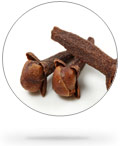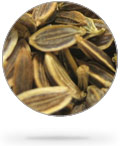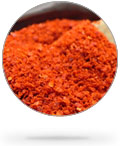Spice Facts |
|
|
 |
Cloves : Cloves are the rich, brown, dried, unopened flower buds of Syzygium aromaticum, an evergreen tree in the myrtle family. The name comes from the French “clou” meaning nail. History/Region of Origin: Cloves are native to the Molucca Islands, now a part of Indonesia. Cloves have been used for thousands of years. One of the earliest references to them says that the Chinese, in order to approach the emperor, had to have a few Cloves in their mouths to sweeten the breath. Storage Tips: Store in cool, dark, dry places. |
|
|
 |
Coriander : Coriander is the seed of Coriandrum sativum, a plant in the parsley family. The seed is globular and almost round, brown to yellow red, and 1/5 inch in diameter with alternating straight and wavy ridges . History/Region of Origin: Coriander is probably one of the first spices used by mankind, having been known as early as 5000 BC. Sanskrit writings dating from about 1500 BC also spoke of it. In the Old Testament “manna” is described as “white like Coriander Seed.” (Exodus 16:31) The Romans spread it throughout Europe and it was one of the first spices to arrive in America. Storage Tips: Store in cool, dark, dry places. |
|
|
 |
Cumin : Cumin is the pale green seed of Cuminum cyminum, a small herb in the parsley family. The seed is uniformly eliptical and deeply furrowed. History/Region of Origin: An ancient spice, Cumin is native to the shores of the Mediterranean Sea and Egypt. Currently it is grown in many places, as it is rather easy to grow and adapts well to many climates. Storage Tips: Store in cool, dark, dry places |
|
|
 |
Curry Powder : Curry Powder is a blend of many spices and is used widely in savory dishes throughout India and Southeast Asia. Storage Tips: Store in cool, dark, dry places. |
|
|
 |
Dill Seed : Dill is a tall, feathery annual, Anethum graveolens, in the parsley family. Both Dill Seed and Weed (dried leaves) come from the same plant History/Region of Origin: Dill is indigenous to the Mediterranean area and southern Russia. It has been used since ancient times. Babylonian and Syrian herbalists used it, and Romans thought it was an effective stimulant for gladiators. Storage Tips: Store in cool, dark, dry places. |
|
|
 |
Fennel Seed: Fennel Seed is the oval, green or yellowish-brown dried fruit of Foeniculum vulgare, a member of the parsley family History/Region of Origin: Fennel is native to southern Europe and the Mediterranean area. The name comes from the Greek word for “marathon” because the famous battle at Marathon (490 BC) against the Persians was fought on a field of Fennel. Pliny said that snakes casting off their skins ate Fennel to restore their eyesight Storage Tips: Store in cool, dark, dry places. |
|
|
 |
Garlic: Garlic is the dried root of Allium sativum, a member of the lily family. Garlic grows in a bulb that consists of a number of cloves. Each clove is protected by a layer of skin, but all are held together in one larger unit by additional layers of skin. History/Region of Origin: Garlic is native to central Asia, but its use spread across the world more than 5000 years ago, before recorded history. It was worshipped by the Egyptians and fed to workers building the Gread Pyramid at Giza, about 2600 BC. Storage Tips: Store in cool, dark, dry places. |
 |
Ginger : Ginger is a flavoring from a tuberous root of Zingiber officinale, a plantin the Ginger family. The root is often dried and ground or “crystallized” with sugar. History/Region of Origin: No one is sure how old Ginger is, or where it came from, since it has never been found growing wild. It was first cultivated by the Chinese and Indians. It was one of the important spices that led to the opening of the spice trade routes. The name Ginger comes from the Sanskrit word “sinabera” meaning “shaped like a horn” because of its resemblance to an antler. Storage Tips: Store in cool, dark, dry places. |
|
 |
Chili Powder : Chili Powder is a blend of spices that usually includes ground chili peppers, oregano, cumin, and garlic powder. History/Region of Origin: Chili Powder is an invention of the 19th century American Southwest. Its development was an American attempt to create a mixture of chili peppers and other herbs similar to those used by the Aztecs in Mexico. Storage Tips: Store in cool, dark, dry places. |
|
 |
Pepper : Pepper is the dried berry of Piper nigrum. This vine which can grow up to ten feet tall is indigenous to India and Asia. Pepper is actually berries that are picked about nine months after flowering. History/Region of Origin: Since the Roman times, Pepper has been the most important spice. The cities of Alexandria, Genoa, and Venice owed their economic success to Pepper. Three thousand year old Sanskrit literature mentions Pepper. It was one of the earliest items traded Asia and Europe. In 1101, victorious Genovese soldiers were each given two pounds of Pepper as a gift for their successful Palestinian conquest. Storage Tips: Store in cool, dark, dry places. |
|
 |
Celery Seed : Celery Seed is the dried fruit of Apium graviolens, a biennial in the parsley family. This is the same genus and species used for growing table celery, although there are particular varieties that are used for the vegetable. The seeds are very small (about 1/16th of an inch), ovoid and light brown. History/Region of Origin: Celery Seed and table celery are grown from a domesticated variety of a wild plant known as “small-age.” Small-age was grown by Greeks and Romans for medicinal qualities. It was associated with funerals and bad luck. Storage Tips: Store in cool, dark, dry places. |
|
 |
Cardamom : Cardamom is the ground seed of a tropical fruit in the ginger family known as Elettaria cardamomum. The seeds are found in oval-shaped fruit pods that are between 1/4- and 1-inch long. History/Region of Origin: As early as the 4th century BC Cardamom was used in India as a medicinal herb. Greeks and Romans imported it as a digestive aid. In Sweden it has become a more popular spice than cinnamon. Storage Tips: Store in cool, dark, dry places. |
|
 |
Bay Leaves : Bay Leaves come from the sweet bay or laurel tree, known botanically as Laurus nobilis. The elliptical leaves of both trees are green, glossy, and grow up to 3 inches long. History/Region of Origin: Ancient Greeks and Romans crowned victors with wreaths of laurel. The term “baccalaureate,” means laurel berry, and refers to the ancient practice of honoring scholars and poets with garlands from the bay laurel tree. Romans felt the leaves protected them against thunder and the plague. Later, Italians and the English thought Bay Leaves brought good luck and warded off evil. Storage Tips: Store in cool, dark, dry places. |
|
 |
Basil : Basil is a bright green, leafy plant, Ocimum basilicum, which is in the mint family. History/Region of Origin: Basil originated in India and Persia, and was both prized and despised by ancient peoples. Though its name means, “be fragrant,” Greeks hated it. However, the Romans loved it and made it a symbol of love and fertility and settlers in early America prized it. Today, Hindus plant it in their homes to bring happiness to the family. Storage Tips: Store in cool, dark, dry places. |
|
 |
Anise Seed : Anise Seed is a gray-brown oval seed from Pimpinella anisum, a plant in the parsley family. It is related to caraway, dill, cumin, and fennel. History/Region of Origin: Anise is native to the Middle East and has been used as a medicine and as a flavor for medicine since prehistoric times. Ancient Romans hung Anise plants near their pillows to prevent bad dreams. They also used Anise to aid digestion and ward off epileptic attacks. Colonists in the New World used it as a medicinal crop too. Storage Tips: Store in cool, dark, dry places. |
|


 Clients
Clients